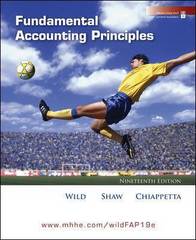Question
A prior period adjustment that corrects income of a prior period requires that an entry be made to a. an income statement account. b. a
A prior period adjustment that corrects income of a prior period
requires that an entry be made to
a. an income statement account.
b. a current year revenue or expense account.
c. an asset account.
d. the retained earnings account
5. The discontinued operations section of the income statement refers
to
a. discontinuance of a product line.
b. the income or loss on products that have been completed and sold.
c. obsolete equipment and discontinued inventory items.
d. the disposal of a significant segment of a business.
6. Indicate the circumstances under which an item would be classified
as an extraordinary item on the income statement.
Unusual in NatureInfrequent in Occurrence
a.YesNo
b.NoYes
c.YesYes
d.NoNo
7. From the standpoint of the issuing company, a disadvantage of using
bonds as a means of long-term financing is that
a. bond interest is deductible for tax purposes.
b. interest must be paid on a periodic basis regardless of earnings.
c. income to stockholders may increase as a result of trading on the
equity.
d. the bondholders do not have voting rights.
8. Bonds that are secured by real estate are termed
a. mortgage bonds.
b. serial bonds.
c. debentures.
d. bearer bonds.
9. The contractual interest rate is always stated as a(n)
a. monthly rate.
b. daily rate.
c. semiannual rate.
d. annual rate.
10. If the market interest rate is greater than the contractual interest
rate, bonds will sell
a. at a premium.
b. at a discount..
c. at face value.
d. only after the stated interest rate is increased.
11. If twenty $1,000 convertible bonds with a carrying value of $25,000
are converted into 3,000 shares of $5 par value common stock, the
journal entry to record the conversion is
a. Bonds Payable ...........................25,000
Common Stock .........................25,000
b. Bonds Payable ...........................20,000
Premium on Bonds Payable ................5,000
Common Stock .........................25,000
c. Bonds Payable ...........................20,000
Premium on Bonds Payable ................5,000
Common Stock .........................15,000
Paid-in Capital in Excess of Par .....10,000
d. Bonds Payable ...........................25,000
Discount on Bonds Payable ............5,000
Common Stock .........................15,000
Paid-in Capital in Excess of Par .....5,000
Step by Step Solution
There are 3 Steps involved in it
Step: 1

Get Instant Access to Expert-Tailored Solutions
See step-by-step solutions with expert insights and AI powered tools for academic success
Step: 2

Step: 3

Ace Your Homework with AI
Get the answers you need in no time with our AI-driven, step-by-step assistance
Get Started


